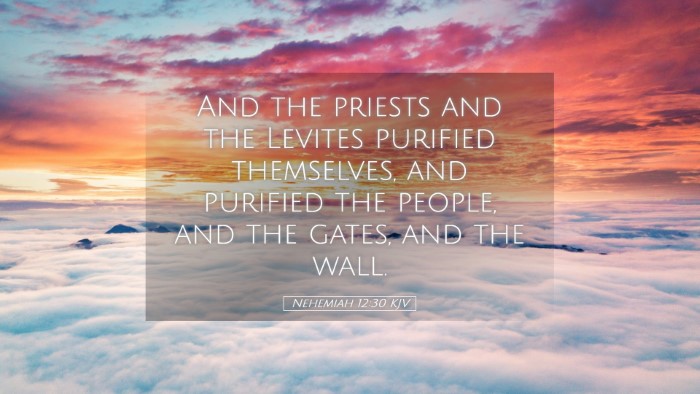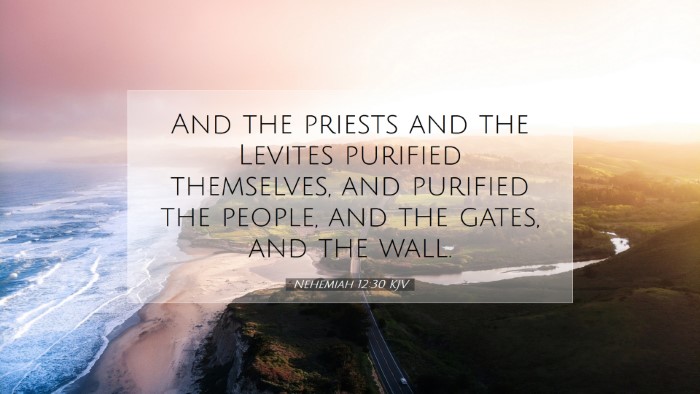Commentary on Nehemiah 12:30
Verse in Context: Nehemiah 12:30 states, “And the priests and the Levites purified themselves and purified the people and the gates and the wall.” This verse encapsulates a significant moment in Israel's history, marking the spiritual restoration of the community following their return from exile.
Introduction
The purification rites described in this passage serve as a testament to the seriousness with which the returning exiles approached their covenant renewal with God.
Insights from Matthew Henry
Priestly Leadership: Henry emphasizes the role of the priests and Levites in this purification process. Their leadership was pivotal in the community's return to proper worship. This highlights how spiritual leaders are to guide the community in holiness.
Symbolism of Purity: The act of purification symbolizes the need for both individual and communal cleansing. It reflects the understanding that to engage in worship, one must first rid themselves of sin and impurity.
Restoration of Worship: This purification act was directly related to the re-establishment of proper worship protocols. Henry points out that the physical act of cleansing corresponded to the spiritual renewal of the people, reinforcing the idea that physical actions can signify deeper spiritual truths.
Insights from Albert Barnes
Ritual and Community: Barnes explains the importance of collective purification. The purification not only involved the priests but also the entire community, indicating that corporate identity is intertwined with individual righteousness.
Historical Context: The historical backdrop of Nehemiah's return from Babylonian captivity is critical; the act of purification served to reinforce the breaking away from past idolatry and to commit to a new covenant relationship with God.
Role of the Gates and Walls: Barnes notes that the gates and walls of Jerusalem were not simply physical structures but also represented the boundaries of the holy community. By purifying these elements, the Israelites were symbolically declaring that their city was once again dedicated to God.
Insights from Adam Clarke
Spiritual Renewal: Clarke asserts the need for purification from both physical and moral corruption. He points out that spiritual rejuvenation is crucial for any kind of effective community life and worship.
Understanding Purification: Clarke delves into the methods of purification that would resonate with these ancient communities, illustrating how these rites were paramount to reintegrating the Jewish people into their traditional worship practices.
Importance of Cleansing: Clarke emphasizes, “Cleansing is not just an external act but an internal transformation.” This highlights a theological principle that external worship must be accompanied by an internal heart change.
Theological Reflections
Communal Holiness: The emphasis on the purification of the people signifies that holiness is communal as much as it is individual. This serves as a vital reminder for contemporary faith communities about the importance of collective sanctification.
Worship and Purity: The connection between purity and worship stresses that spiritual conditions must be met before approaching God in worship. This foundational principle resonates deeply in both Old and New Testament contexts.
Modern Application: Today, churches and congregants are called to self-examination and repentance. The practice of 'purifying' our 'gates and walls' can manifest in how communities deal with sin, support one another, and strive for holiness.
Conclusion
The act of purification described in Nehemiah 12:30 serves as a powerful reminder of the necessity for both individual and communal commitment to holiness. The insights drawn from Henry, Barnes, and Clarke collectively emphasize the significance of priestly leadership, historical context, and the overarching theological themes of purification, enabling pastors, students, theologians, and Bible scholars to deeply engage with the text.


